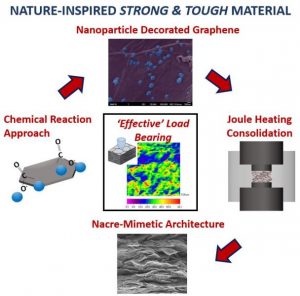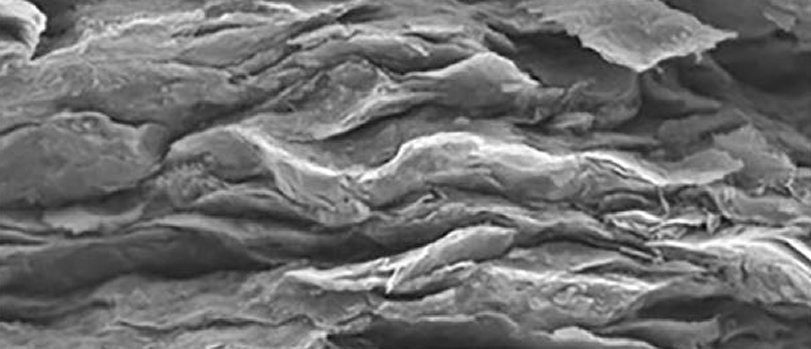Nature can provide cues to develop next generation of ultra strong and tough materials. Nacre, found inside certain seashells, has remarkable mechanical strength, stiffness and it resists cracking under excessive loads. This is possible because of very interesting ‘brick-and-mortar’ structural arrangement of hard ceramic plates bonded together by soft organic materials acting as glue.
Professor Arvind Agarwal and his research group at Florida International University developed Nacre-mimicking composite material of graphene and copper. 2D graphene displays extraordinary mechanical strength and stiffness. This inspired the team to adopt graphene platelets as the strong load bearing constituent. They decided to use ductile copper metal as a glue between the graphene platelets to achieve flexibility.
 A simple chemical reaction approach was employed to deposit nanosized copper droplets on the graphene sheets. The copper-decorated graphene platelets were then stacked together and sintered. Agarwal’s research group has expertise on Spark Plasma Sintering (SPS), a technique in which a pulsed DC current produces localized Joule heating while a uniaxial pressure is simultaneously applied, aiding in rapid bonding/ welding of the materials. During SPS, the copper droplets underwent partial melting and were spread out between graphene flakes. This hybrid, lamellar composite demonstrated 600% improvement in the work of indentation, as compared to a pure graphene monolith. Copper layers aid in excellent load transfer between graphene platelets by providing intimate interface adhesion. Dispersion of localized indentation stresses controls the crack formation. This lightweight composite material can have potential applications in aerospace and automotive structures. The ability to resist impact effectively is vital for developing safer automobiles.
A simple chemical reaction approach was employed to deposit nanosized copper droplets on the graphene sheets. The copper-decorated graphene platelets were then stacked together and sintered. Agarwal’s research group has expertise on Spark Plasma Sintering (SPS), a technique in which a pulsed DC current produces localized Joule heating while a uniaxial pressure is simultaneously applied, aiding in rapid bonding/ welding of the materials. During SPS, the copper droplets underwent partial melting and were spread out between graphene flakes. This hybrid, lamellar composite demonstrated 600% improvement in the work of indentation, as compared to a pure graphene monolith. Copper layers aid in excellent load transfer between graphene platelets by providing intimate interface adhesion. Dispersion of localized indentation stresses controls the crack formation. This lightweight composite material can have potential applications in aerospace and automotive structures. The ability to resist impact effectively is vital for developing safer automobiles.
Professor Agarwal says the unique processing approach shown in this study is simple, scalable, and can be applied to an array of 2D material systems to achieve bio-inspired microstructures. The next steps are to understand how the material responds to different mechanical stress conditions, such as tension, compression, flexure and fatigue over long periods of loading.

















